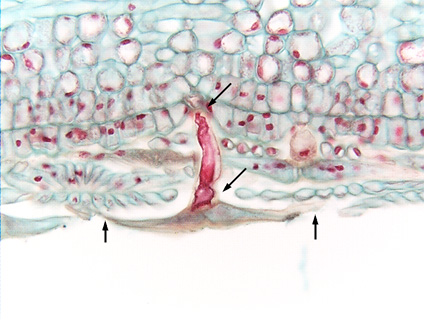 Fig.
10.4-4. Transverse section of olive leaf (Olea
purpurea). This epidermis has peltate
trichomes, trichomes that have a stalk (between diagonal arrows) and
a flat disk-shaped top (between vertical arrows). This is in the lower
epidermis, and the upper end of the stalk is embedded between ordinary epidermis
cells. The ordinary epidermis cells are a bit difficult to see because there is
so much material on either side of them: the material above them is leaf
mesophyll, and the material below them are the tops of other trichomes. Because
they have such wide, disk-shaped tops, most sections cut through just the tops
and only occasionally catch a stalk. See the next figure for a low magnification
view of many trichomes on this leaf.
Fig.
10.4-4. Transverse section of olive leaf (Olea
purpurea). This epidermis has peltate
trichomes, trichomes that have a stalk (between diagonal arrows) and
a flat disk-shaped top (between vertical arrows). This is in the lower
epidermis, and the upper end of the stalk is embedded between ordinary epidermis
cells. The ordinary epidermis cells are a bit difficult to see because there is
so much material on either side of them: the material above them is leaf
mesophyll, and the material below them are the tops of other trichomes. Because
they have such wide, disk-shaped tops, most sections cut through just the tops
and only occasionally catch a stalk. See the next figure for a low magnification
view of many trichomes on this leaf.